FIG. 3.
Tubulin hyperglutamylation stabilizes cell body microtubules. (A to I′) Confocal microscopic images of cells stained with anti-α-tubulin MAb 12G10. (A and B) Wild-type cells grown without (A) or with (B) 40 μM paclitaxel. Note the appearance of thick bundles of subcortical microtubules in the drug-treated cells. (C to G). Cells expressing GFP-Ttll6Ap or its truncated variant M241-V929 that are uninduced (C) and induced with cadmium (D to G). Note the appearance of bundles of microtubules in the cell body and macronuclei (arrow) in the overproducing cell. (H to I′) Overexpression of GFP-Ttll6Ap protects subcortical and cytoplasmic microtubules against oryzalin-induced depolymerization. Wild-type (H and H′) and GFP-Ttll6Ap-overexpressing (I and I′) cells grown for 4 h in the presence of 2.5 μg of CdCl2/ml were treated for 30 min with 10 μM oryzalin. Panels H′ and I′ show the internal sections of cells shown in panels H and I, respectively. Note the nearly complete depolymerization of cell body microtubules in the wild-type cells but not in Ttll6Ap-overproducing cells. Bar, 10 μm. (J) A graph documents the percentages of wild-type and GFP-Ttll6Ap cells with cytoplasmic microtubules during oryzalin treatment.

